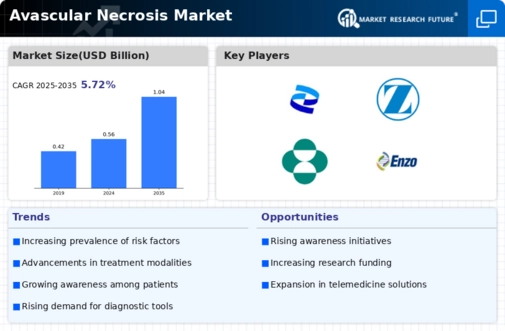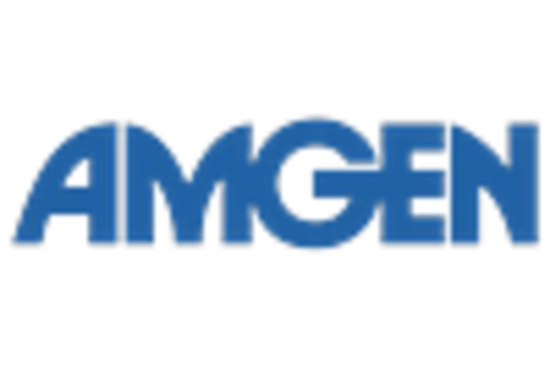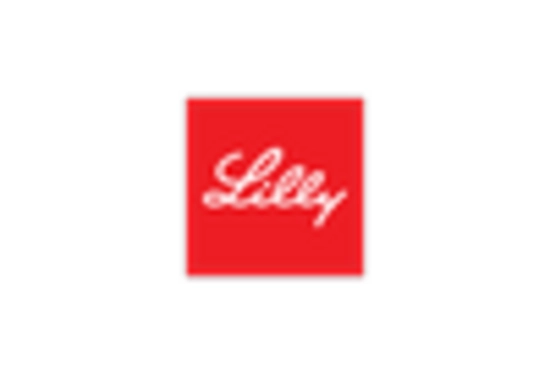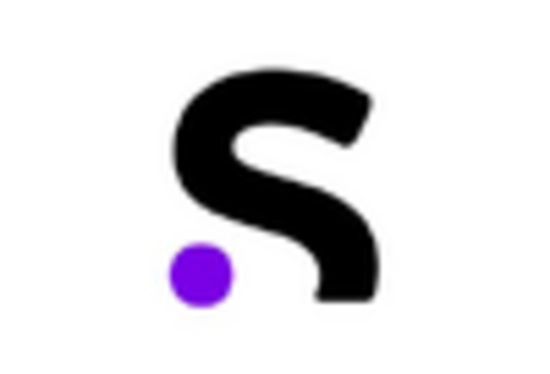Trauma Related Avascular Necrosis (AVN)
Non-Trauma Related Avascular Necrosis (AVN)
Nonsteroidal Anti-Inflammatory Drugs (NSAIDS)
Cholesterol Lowing Drugs
Osteoporosis Drugs
Blood Thinners
Others
Imaging
Biopsy
CT Scan
PET
X- Ray
Hospital Pharmacies
Retail Pharmacies
Online Pharmacies
North America Avascular Necrosis Products by TypeTrauma Related Avascular Necrosis (AVN)
Non-Trauma Related Avascular Necrosis (AVN)
North America Avascular Necrosis by TreatmentNonsteroidal Anti-Inflammatory Drugs (NSAIDS)
Cholesterol Lowing Drugs
Osteoporosis Drugs
Blood Thinners
Others
North America Avascular Necrosis by DiagnosisImaging
Biopsy
CT Scan
PET
X- Ray
North America Avascular Necrosis by End userHospital Pharmacies
Retail Pharmacies
Online Pharmacies
US Avascular Necrosis Products by TypeTrauma Related Avascular Necrosis (AVN)
Non-Trauma Related Avascular Necrosis (AVN)
US Avascular Necrosis by TreatmentNonsteroidal Anti-Inflammatory Drugs (NSAIDS)
Cholesterol Lowing Drugs
Osteoporosis Drugs
Blood Thinners
Others
US Avascular Necrosis by DiagnosisImaging
Biopsy
CT Scan
PET
X- Ray
US Avascular Necrosis by End userHospital Pharmacies
Retail Pharmacies
Online Pharmacies
CANADA Avascular Necrosis Products by TypeTrauma Related Avascular Necrosis (AVN)
Non-Trauma Related Avascular Necrosis (AVN)
CANADA Avascular Necrosis by TreatmentNonsteroidal Anti-Inflammatory Drugs (NSAIDS)
Cholesterol Lowing Drugs
Osteoporosis Drugs
Blood Thinners
Others
CANADA Avascular Necrosis by DiagnosisImaging
Biopsy
CT Scan
PET
X- Ray
CANADA Avascular Necrosis by End userHospital Pharmacies
Retail Pharmacies
Online Pharmacies
Europe Avascular Necrosis Products by TypeTrauma Related Avascular Necrosis (AVN)
Non-Trauma Related Avascular Necrosis (AVN)
Europe Avascular Necrosis by TreatmentNonsteroidal Anti-Inflammatory Drugs (NSAIDS)
Cholesterol Lowing Drugs
Osteoporosis Drugs
Blood Thinners
Others
Europe Avascular Necrosis by DiagnosisImaging
Biopsy
CT Scan
PET
X- Ray
Europe Avascular Necrosis by End userHospital Pharmacies
Retail Pharmacies
Online Pharmacies
Germany Outlook (USD Billion, 2018-2032)
Germany Avascular Necrosis Products by TypeTrauma Related Avascular Necrosis (AVN)
Non-Trauma Related Avascular Necrosis (AVN)
Germany Avascular Necrosis by TreatmentNonsteroidal Anti-Inflammatory Drugs (NSAIDS)
Cholesterol Lowing Drugs
Osteoporosis Drugs
Blood Thinners
Others
Germany Avascular Necrosis by DiagnosisImaging
Biopsy
CT Scan
PET
X- Ray
Germany Avascular Necrosis by End userHospital Pharmacies
Retail Pharmacies
Online Pharmacies
France Avascular Necrosis Products by TypeTrauma Related Avascular Necrosis (AVN)
Non-Trauma Related Avascular Necrosis (AVN)
France Avascular Necrosis by TreatmentNonsteroidal Anti-Inflammatory Drugs (NSAIDS)
Cholesterol Lowing Drugs
Osteoporosis Drugs
Blood Thinners
Others
France Avascular Necrosis by DiagnosisImaging
Biopsy
CT Scan
PET
X- Ray
France Avascular Necrosis by End userHospital Pharmacies
Retail Pharmacies
Online Pharmacies
UK Avascular Necrosis Products by TypeTrauma Related Avascular Necrosis (AVN)
Non-Trauma Related Avascular Necrosis (AVN)
UK Avascular Necrosis by TreatmentNonsteroidal Anti-Inflammatory Drugs (NSAIDS)
Cholesterol Lowing Drugs
Osteoporosis Drugs
Blood Thinners
Others
UK Avascular Necrosis by DiagnosisImaging
Biopsy
CT Scan
PET
X- Ray
UK Avascular Necrosis by End userHospital Pharmacies
Retail Pharmacies
Online Pharmacies
ITALY Avascular Necrosis Products by TypeTrauma Related Avascular Necrosis (AVN)
Non-Trauma Related Avascular Necrosis (AVN)
ITALY Avascular Necrosis by TreatmentNonsteroidal Anti-Inflammatory Drugs (NSAIDS)
Cholesterol Lowing Drugs
Osteoporosis Drugs
Blood Thinners
Others
ITALY Avascular Necrosis by DiagnosisImaging
Biopsy
CT Scan
PET
X- Ray
ITALY Avascular Necrosis by End userHospital Pharmacies
Retail Pharmacies
Online Pharmacies
Spain Avascular Necrosis Products by TypeTrauma Related Avascular Necrosis (AVN)
Non-Trauma Related Avascular Necrosis (AVN)
Spain Avascular Necrosis by TreatmentNonsteroidal Anti-Inflammatory Drugs (NSAIDS)
Cholesterol Lowing Drugs
Osteoporosis Drugs
Blood Thinners
Others
Spain Avascular Necrosis by DiagnosisImaging
Biopsy
CT Scan
PET
X- Ray
Spain Avascular Necrosis by End userHospital Pharmacies
Retail Pharmacies
Online Pharmacies
Rest Of Europe Avascular Necrosis Products by TypeTrauma Related Avascular Necrosis (AVN)
Non-Trauma Related Avascular Necrosis (AVN)
Rest Of Europe Avascular Necrosis by TreatmentNonsteroidal Anti-Inflammatory Drugs (NSAIDS)
Cholesterol Lowing Drugs
Osteoporosis Drugs
Blood Thinners
Others
Rest Of Europe Avascular Necrosis by DiagnosisImaging
Biopsy
CT Scan
PET
X- Ray
Rest Of Europe Avascular Necrosis by End userHospital Pharmacies
Retail Pharmacies
Online Pharmacies
Asia-Pacific Avascular Necrosis Products by TypeTrauma Related Avascular Necrosis (AVN)
Non-Trauma Related Avascular Necrosis (AVN)
Asia-Pacific Avascular Necrosis by TreatmentNonsteroidal Anti-Inflammatory Drugs (NSAIDS)
Cholesterol Lowing Drugs
Osteoporosis Drugs
Blood Thinners
Others
Asia-Pacific Avascular Necrosis by DiagnosisImaging
Biopsy
CT Scan
PET
X- Ray
Asia-Pacific Avascular Necrosis by End userHospital Pharmacies
Retail Pharmacies
Online Pharmacies
China Avascular Necrosis Products by TypeTrauma Related Avascular Necrosis (AVN)
Non-Trauma Related Avascular Necrosis (AVN)
China Avascular Necrosis by TreatmentNonsteroidal Anti-Inflammatory Drugs (NSAIDS)
Cholesterol Lowing Drugs
Osteoporosis Drugs
Blood Thinners
Others
China Avascular Necrosis by DiagnosisImaging
Biopsy
CT Scan
PET
X- Ray
China Avascular Necrosis by End userHospital Pharmacies
Retail Pharmacies
Online Pharmacies
Japan Avascular Necrosis Products by TypeTrauma Related Avascular Necrosis (AVN)
Non-Trauma Related Avascular Necrosis (AVN)
Japan Avascular Necrosis by TreatmentNonsteroidal Anti-Inflammatory Drugs (NSAIDS)
Cholesterol Lowing Drugs
Osteoporosis Drugs
Blood Thinners
Others
Japan Avascular Necrosis by DiagnosisImaging
Biopsy
CT Scan
PET
X- Ray
Japan Avascular Necrosis by End userHospital Pharmacies
Retail Pharmacies
Online Pharmacies
India Avascular Necrosis Products by TypeTrauma Related Avascular Necrosis (AVN)
Non-Trauma Related Avascular Necrosis (AVN)
India Avascular Necrosis by TreatmentNonsteroidal Anti-Inflammatory Drugs (NSAIDS)
Cholesterol Lowing Drugs
Osteoporosis Drugs
Blood Thinners
Others
India Avascular Necrosis by DiagnosisImaging
Biopsy
CT Scan
PET
X- Ray
India Avascular Necrosis by End userHospital Pharmacies
Retail Pharmacies
Online Pharmacies
Australia Avascular Necrosis Products by TypeTrauma Related Avascular Necrosis (AVN)
Non-Trauma Related Avascular Necrosis (AVN)
Australia Avascular Necrosis by TreatmentNonsteroidal Anti-Inflammatory Drugs (NSAIDS)
Cholesterol Lowing Drugs
Osteoporosis Drugs
Blood Thinners
Others
Australia Avascular Necrosis by DiagnosisImaging
Biopsy
CT Scan
PET
X- Ray
Australia Avascular Necrosis by End userHospital Pharmacies
Retail Pharmacies
Online Pharmacies
Rest of Asia-Pacific Avascular Necrosis Products by TypeTrauma Related Avascular Necrosis (AVN)
Non-Trauma Related Avascular Necrosis (AVN)
Rest of Asia-Pacific Avascular Necrosis by TreatmentNonsteroidal Anti-Inflammatory Drugs (NSAIDS)
Cholesterol Lowing Drugs
Osteoporosis Drugs
Blood Thinners
Others
Rest of Asia-Pacific Avascular Necrosis by DiagnosisImaging
Biopsy
CT Scan
PET
X- Ray
Rest of Asia-Pacific Avascular Necrosis by End userHospital Pharmacies
Retail Pharmacies
Online Pharmacies
Rest of the World Avascular Necrosis Products by TypeTrauma Related Avascular Necrosis (AVN)
Non-Trauma Related Avascular Necrosis (AVN)
Rest of the World Avascular Necrosis by TreatmentNonsteroidal Anti-Inflammatory Drugs (NSAIDS)
Cholesterol Lowing Drugs
Osteoporosis Drugs
Blood Thinners
Others
Rest of the World Avascular Necrosis by DiagnosisImaging
Biopsy
CT Scan
PET
X- Ray
Rest of the World Avascular Necrosis by End userHospital Pharmacies
Retail Pharmacies
Online Pharmacies
Middle East Avascular Necrosis Products by TypeTrauma Related Avascular Necrosis (AVN)
Non-Trauma Related Avascular Necrosis (AVN)
Middle East Avascular Necrosis by TreatmentNonsteroidal Anti-Inflammatory Drugs (NSAIDS)
Cholesterol Lowing Drugs
Osteoporosis Drugs
Blood Thinners
Others
Middle East Avascular Necrosis by DiagnosisImaging
Biopsy
CT Scan
PET
X- Ray
Middle East Avascular Necrosis by End userHospital Pharmacies
Retail Pharmacies
Online Pharmacies
Africa Avascular Necrosis Products by TypeTrauma Related Avascular Necrosis (AVN)
Non-Trauma Related Avascular Necrosis (AVN)
Africa Avascular Necrosis by TreatmentNonsteroidal Anti-Inflammatory Drugs (NSAIDS)
Cholesterol Lowing Drugs
Osteoporosis Drugs
Blood Thinners
Others
Africa Avascular Necrosis by DiagnosisImaging
Biopsy
CT Scan
PET
X- Ray
Africa Avascular Necrosis by End userHospital Pharmacies
Retail Pharmacies
Online Pharmacies
Latin America Avascular Necrosis Products by TypeTrauma Related Avascular Necrosis (AVN)
Non-Trauma Related Avascular Necrosis (AVN)
Latin America Avascular Necrosis by TreatmentNonsteroidal Anti-Inflammatory Drugs (NSAIDS)
Cholesterol Lowing Drugs
Osteoporosis Drugs
Blood Thinners
Others
Latin America Avascular Necrosis by DiagnosisImaging
Biopsy
CT Scan
PET
X- Ray
Latin America Avascular Necrosis by End userHospital Pharmacies
Retail Pharmacies
Online Pharmacies

















Leave a Comment